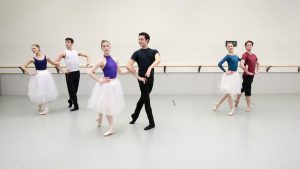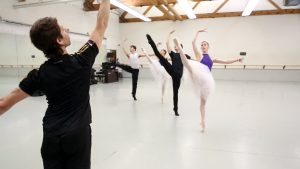Have you heard about BalletMet 2?
Created in 2014, BalletMet 2 is a one-year program for dancers who are looking to begin their professional careers. Through the program, dancers learn classical and contemporary repertoire which they perform in BalletMet 2’s outreach program, Movement Makers, and also on stage in BalletMet’s seasonal company productions.
Ambre Emory-Maier, Director of Education and Associate Director of BalletMet 2, explains that because BalletMet is an unranked company, BalletMet 2 dancers get to dance pretty predominate roles in ballets that are choreographed throughout the season.
As BalletMet 2 continues to grow in its fourth year, one exciting new addition has been Associate Director, Andres Estevez. With his experience as a company dancer and unique coaching style, Andres acts as the “yin” to Ambre’s “yang.”
We recently sat down with Ambre, Andres, and BalletMet 2 alum and company dancer, Arielle Friedman, to gain more insight into what makes BalletMet 2 such a unique program.
What type of repertoire can a dancer expect to learn when joining BalletMet 2?
Ambre: A lot of the repertoire is Edwaard Liang’s choreography and other notable choreographers, like James Kudelka, Michael Pink, Gustavo Ramirez Sansano and Val Caniparoli. BalletMet 2 works with the artistic staff here, learning classically based choreography, variations and pas de deuxs from some of the wonderful classic ballets like Sleeping Beauty and romantic ballets like Giselle.
Andres: They also have separate repertoires for collaborations outside of BalletMet. With the [Columbus] Opera right now they are working on Carmen. It’s great for them because they are young and able to learn more.
Arielle: I worked mostly with Edwaard Liang’s choreography my year and it was helpful because before I had come here I had barely had any contemporary experience and working with him so much, one-on-one, was essential in being able to move forward with my career.
What makes BalletMet 2 stand out from other programs?
Ambre: We know that at the end of the first year at BalletMet 2, that all of the dancers that chose to go on to dance professionally got jobs. And as they move into that second or third year of professional work many of them continue to work professionally, though some of them do decide to go to college at some point.
I think the BalletMet 2 experience has really prepared them for the rigor of company life. They’re getting a huge education in contemporary partnering and many dancers when they leave their training schools, and even dancers who have gone to college, they don’t have that training in the contemporary partnering style.
Andres: BalletMet 2 is very interesting because besides all of the classes we are offering, there is also a lot of acting and mentally preparing the dancer for what they are going to face on stage. Ambre does a great job with that.
Arielle: BalletMet 2’s outreach program, Movement Makers, is also really important because it brings ballet to kids that otherwise wouldn’t experience a live performance or ballet in general. You get to open up this new world of dance and art to these young kids all across Columbus and it’s really special to see how excited they are in the auditoriums at the schools because a lot of the time when you’re dancing on stage you can’t witness that because it’s blackness.

What’s your teaching style like?
Ambre: For me, I have a wide background of dance training and performance experience so I try to bring all of that background and knowledge when I’m in rehearsal. As someone who has spent a lot of time working with the anatomy, when I’m in rehearsal I’m looking at the function of the body but I’m also looking at the emotional intent and the energetic blueprint that’s being projected from the dancer to the audience. I also bring in this aspect of mindfulness when I’m working with the dancers. It’s an intense attention and receptivity when you’re performing and dancing with someone else on stage.
Andres: First of all they need to learn the choreography very well so they can learn what the role requires; what type of feeling, movement, and quality. I focus a little bit on everything but mostly that they give feeling and interpretation and use their body in the proper way to deliver the role because the audience is always following the title. In Romeo and Juliet, they aren’t coming to see Andres dance; they’re coming to see Romeo dance. My focus in rehearsal is to help them find their way to deliver that role.
This year BalletMet 2 has two Associate Directors. How is it working together?
Ambre: Andres and I are nice counter parts. I think we are both really patient but we come from opposite sides of the dance world in some ways. Andres is from Cuba, I’m from America. We have a little bit of a different background in training. We have a masculine person that knows a lot about partnering and male steps in classical ballets and then there’s me who has this larger perspective about ballet, contemporary dance, and ballroom dance and how it all plays into it.
Andres: We work very well together. We complement each other. I have a lot of stuff she has too but my quality is not her quality and her quality is not my quality. I wouldn’t change her for anyone. Every time she does an exercise with them about acting and mentality, the work that she does preparing the dancer mentally, I cannot teach that. She makes them more secure of themselves up on stage. We learn from each other.

How does BalletMet 2 help transition young dancers into their professional career?
Ambre: We work with our dancers when audition season comes around to help them compile their resumes and select really strong video resumes to send out to companies. BalletMet has a lot of inner-networking too. BalletMet 2 dancers are able to build relationships with the artistic staff and choreographers that come to BalletMet. When it comes time to get a job and they need an introduction to an artistic director, they have that contact from BalletMet.
Arielle: It was a lot easier of a transition than having just gone into a company right off the bat. You learn so much that otherwise you wouldn’t be exposed to or have the opportunity to learn. It really taught me how to learn in the back of the studio. It’s very easy when you’re in the back to not pay attention. As BalletMet 2 you’re expected to know every piece of choreography and every part because you’re thrown in a lot of the time. It forces you to be aware.
Also because BalletMet is an AGMA [unranked] company you have a lot of opportunities. You can be considered for roles even though you’re in BalletMet 2. In my year I was lucky enough to be cast in a lot of the company pieces and perform in them. It’s really special because that doesn’t happen in a lot of places and all of the company members are very supportive. Even if you get a role that usually would be a company role, and you’re BalletMet 2, they’re so supportive. They’ll watch and give you notes, anything to help you succeed. I learned so much from my co-workers that year and every day by watching them in class and asking questions.
What do you look for when selecting dancers for BalletMet 2 and what’s the process like after they’re accepted?
Andres: I like dancers who give the soul, who dance from inside out. Of course on top of that you need to have the technique required for ballet, contemporary, and everything. But I like the dancers who can do everything. Some people do a lot of turns, some people have so much passion, and some have a very high jump. The second company should have all that in a minimal level and my job is to bring that to a high level. We are in charge to bring that up to 100%.
Ambre: I look for how well the dancer’s training has been. We’re looking at how well their body is conditioned and if they’re using it to the best of their ability. We’re searching for musicality and we’re looking for a dancer that has some special quality or spark that draws attention to them. We want someone that is willing to try something and fully present in the room.
Once they are selected they receive a letter of offer, a stipend of $900 a month for their work and a shoe allowance. From there, they arrive here in the summer so they stay in shape and we can start teaching them the repertoire. We do a lot of orienting with them to get them to start feeling comfortable. You really can’t hide here. There’s no standing in the back and just marking through things. We’re teaching them expectations and we’re talking to them very quickly about what we see they need to work on right away and what we also really like about them too. We’re helping them achieve their goals.[vc_video link=”https://www.youtube.com/watch?v=PU-ffCzGtt0″]

